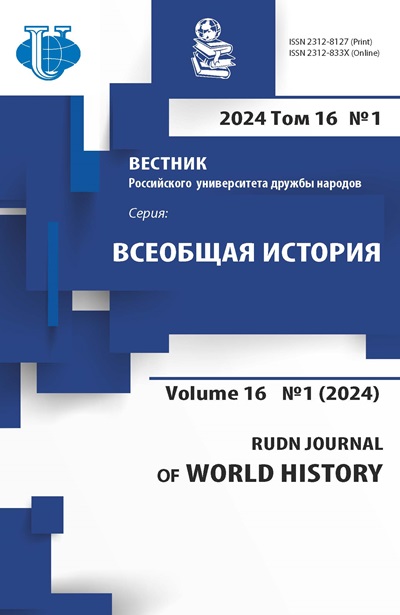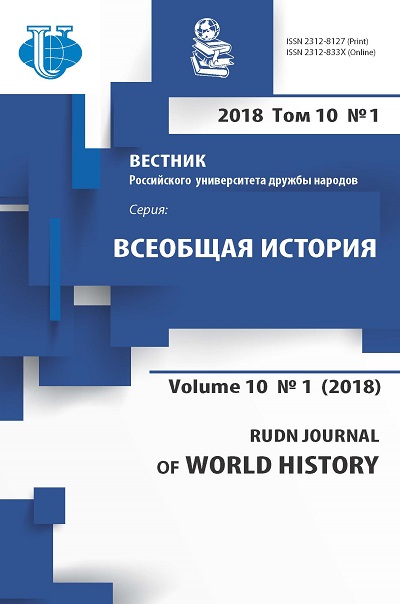CHRISTIANS AND JEWS IN THE ADMINISTRATION SYSTEM OF AHMAD-PASHA AL-JAZZAR IN THE LATE XVIII - EARLY XIX CENTURIES
- Authors: Kasumov R.1
-
Affiliations:
- Department of Near and Middle Eastern History IAAS MSU
- Issue: Vol 10, No 1 (2018)
- Pages: 86-96
- Section: Oriental Studies
- URL: https://journals.rudn.ru/world-history/article/view/18806
- DOI: https://doi.org/10.22363/2312-8127-2018-10-1-86-96
Cite item
Full Text
Abstract
The article concerns the analysis of the role and place of the representatives of the nonMuslim communities in the administration system of the territories controlled by Ahmad-pasha al-Jazzar, the most powerful Syrian provincial governor in the second half of the 18th - early 19th centuries, in the late period of his rule. The author makes an attempt to distinguish the main features of the position of the non-Muslim officials in the administration system of Ottoman Syria.
Keywords
About the authors
Rufat Kasumov
Department of Near and Middle Eastern History IAAS MSU
Author for correspondence.
Email: krufat@mail.ru
postgraduate student of the Department of Near and Middle Eastern History of IAAS MSU
11 Mohovaya St., Moscow, 125009, RussiaReferences
- Al-Aura, Ibrakhim. Tarikh valaiet Suleiman basha al-Adil [The History of the Rule of Suleiman Pasha the Just]. Sidon, 1936.
- Bazili C.M. Siriya i Palestina pod turetskim pravitel’stvom v istoricheskom i politicheskom otnosheniyakh [Syria and Palestine under the Turkish Rule in Historical and Political Contexts]. Moscow, 2007.
- Zhantiev D.R. Traditsiya i modernizatsiya na Arabskom Vostoke: reformy v siriiskikh provintsiyakh Osmanskoi imperii v kontse XVIII – nachale XX vekа [The Tradition and the Modernization in the Arab East: Reforms in the Syrian Provinces of the Ottoman Empire in late 18th – early 20th centuries]. Moscow, 1998.
- Iz beirutskoi tserkovnoi letopisi XVI–XVIII v. [From a Beirut Church Chronichles of 16th–18th centuries]. Translated by Krymskiy A.E. Drevnosti Vostochnyya. V. III. Moscow, 1907. P. 31–89.
- Kratkaya istoriya episkopov, voskhodivshikh na vysokuyu arkhiereiskuyu kafedru goroda Beiruta [A Brief History of the Bishops, who Rised on the High Episcopal Chair of the City of Beirut]. Translated by Konstantinopol’skii I.G. Araby-khristiane v istorii i literature Blizhnego Vostoka. Moscow, 2013. P. 162–201.
- Meyer M.S. Osmanskaya imperiya v XVIII veke: cherty strukturnogo krizisa [The Ottoman Empire in the 18th Сentury: Features of the Structural Crisis]. Moscow, 1991.
- Mishaqa, Mikha’il. Mashhad al-iyan bi-hawadith Suriyya wa Lubnan [An Eyewitness to the Events in Syria and Lebanon]. Tarikh Bilad al-Sham fi al-qarn al-tasia ashar [The History of Bilad al-Sham in the 19th century]. Damascus, 2006.
- Pahchenko C.A. Blizhnevostochnoe Pravoslavie pod osmanskim vladychestvom. Pervye tri stoletiya. 1516–1831 [The Eastern Orthodox Church under the Ottoman Rule. The First Three Centuries. 1516–1831]. Moscow, 2013.
- Tarikh khavadis al-Sham va Lubnan au tarikh Mikha’il al-Dimashki (1192–1257 H) [The Chronicle of the Events in Syria and Lebanon or the Chronicle of Mikha’il al-Dimashki. 1782–1841]. Damascus, 1981.
- Al-Shihabi, Haydar Ahmad. Tarikh Ahmad Basha al-Jazzar [The History of Ahmad Pasha al-Jazzar]. Beirut, 1955.
- Buckingham J.S. Travels in Palestine through the Countries of Bashan and Gilead. London, 1821.
- Masters B.A. Christians and Jews in the Ottoman Arab World: the Roots of Sectarianism. Cambridge University Press, 2001.













